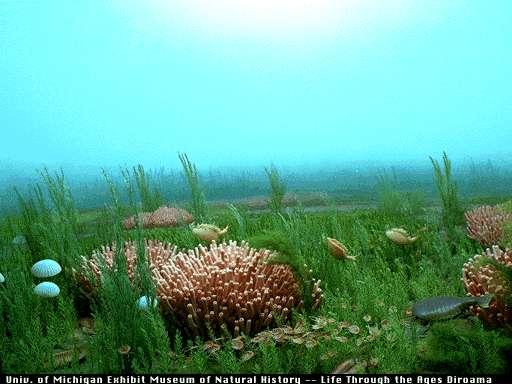
| Cambrian Period | ||
| Paleozoic: Cambrian Period |
The Cambrian: 2 |
| Ediacaran | Neoproterozoic | Paleozoic | ||
| Ordovician | Mesozoic | Terreneuvian | Timescale |
The main issue concerning Cambrian vertebrates is whether there were any. It seems likely that at least one lineage of vertebrates existed before the Ordovician, but the issue is not entirely settled. Two organisms in particular are possible Cambrian vertebrates: Haikouichthys and Anatolepis. In addition, two other vertebrate lineages are ancient enough that it would be reasonable to suppose they originated in the Cambrian, even without a clear fossil record: conodonts and thelodonts.
Haikouichthys was originally described by Shu et al. (1999) as one of two possible vertebrates on the basis of unique specimens from Chengjiang. The other specimen, Myllokunmingia, remains unique. It has also been suggested that Myllokunmingia is the same as Haikouichthys. Hou et al. (2002). However, the issue of Myllokunmingia's exact characteristics and affinities became somewhat less urgent since, shortly thereafter, five hundred new specimens of Haikouichthys were found near Haikou. Portions of the anatomy were then redescribed on the basis of this massive body of new data by an all-star cast of Chinese and Western early vertebrate specialists. They pronounced Haikouichthys to be a certifiable vertebrate on the basis of numerous characters. Shu et al. (2002). We hasten to add that this does not place Haikouichthys in the Vertebrata, as we use that term in the Vertebrate section of Palaeos. To the contrary, the cladogram of Shu et al. 2003) identifies Haikouichthys as a basal chordate, or possibly a basal craniate hags > hagfish), but not a vertebrate (vampires > lampreys). Nevertheless, Haikouichthys has a number of characteristics thought to be vertebrate synapomorphies.

For those with an interest in conodonts, note how wonderfully this interpretation of Haikouichthys squares with our heterodox interpretation of the conodont cranium. One more organism of this sort, and we'll actually start taking ourselves seriously...
By contrast, Haikouella, originally thought to be a stem vertebrate, is now regarded as a Vetulicolian or other stem deuterostome. Shu & Conway Morris (2003) have made a point of "emphatically contest[ing]" the vertebrate affinities of Haikouella, emphasizing the absence of eyes, notochord, myomeres, or brain.
 University of California Museum of Paleontology -- The Cambrian Period, at the University of California Museum of Paleontology. best on the web
University of California Museum of Paleontology -- The Cambrian Period, at the University of California Museum of Paleontology. best on the web
 The Cambrian World - Stratigraphy - Localities - Life in the Cambrian
The Cambrian World - Stratigraphy - Localities - Life in the Cambrian
The Cambrian Period - good essay, from from Peripatus
The Cambrian Period - Dr Pamela Gore - some useful study notes, complete with links and a few photos of several types of trilobite. An excellent introduction, if you don't mind the Geology 102 format. Includes material on the famous Burgess Shale site.
American Scientist: January-February 1997 - Origin of Animal Body Plans - explains how multicelluar animals suddenly appeared during the Cambrian, after billions of years of nothing but micro-organisms
![]() MSN Encarta - Cambrian Period
- Short entry, summarizes the life forms and geologic activity that mark this time period.
MSN Encarta - Cambrian Period
- Short entry, summarizes the life forms and geologic activity that mark this time period.
Wonderful Life : The Burgess Shale and the Nature of History by Stephen Jay Gould - classic work on early Metazoan evolution, also historic overview of the discovery of the Burgess Shale fauna. Argues that many Burgess Shale remains belong to extinct phyla with no know relatives. Raises some interesting philosophical questions on the evolution of life. Some of Gould's claims have since been refuted in the light of subsequent research (e.g. Hallucinagenia has turned out to be a lobopod), but he still makes many valid points.
The Crucible of Creation : The Burgess Shale and the Rise of Animals by Simon Conway Morris, - a very facscinating and readable alternative to Gould - argues that rather than a bush of many unrelated extinct lineages, these ancient organisms all fit together on an evolutionary tree. My own stance is probably somewhere between that of Gould and Morris.